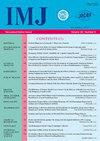心肌纤维化的发病机制:以细胞外基质为主
Q4 Medicine
引用次数: 1
摘要
主要心血管疾病影响心肌重构的过程,进而导致心脏收缩或舒张期功能障碍的形成。心肌功能障碍的形成主要与左室肥厚有关,在血流动力学负荷下,首先壁刚性增加,其次心肌纤维化形成。后者是胶原积累引起的肥厚过程的关键因素之一,胶原积累导致左心室舒张过程加重。心脏重构被定义为一组分子、细胞和间质改变,临床表现为心肌损伤引起的心脏大小、形状和功能的改变。已经确定,纤维化是左心室负荷过重患者损伤的早期形态学征象,也是舒张和收缩功能障碍发展的一个因素。代偿性左心室肥厚由于纤维化的发展转变为心力衰竭。在肥厚中,弹性III型胶原含量减少,刚性I型胶原含量增加。强调细胞外基质在心肌纤维化形成中的重要作用。心肌纤维化是细胞外基质的病理重塑过程,导致其组成异常和心肌功能障碍。细胞外基质在组织损伤的器官发生和创伤后愈合中起着关键作用。对细胞外基质细胞间相互作用的研究将有助于更好地理解心脏几何形状和功能变化的机制,对基质成分活性的研究将为心脏重构分子机制的靶向治疗提供新的机会。关键词:舒张功能障碍,细胞外基质,心肌纤维化,心肌细胞,成纤维细胞。本文章由计算机程序翻译,如有差异,请以英文原文为准。
PATHOGENETIC ROLE OF MYOCARDIAL FIBROSIS: FOCUS ON EXTRACELLULAR MATRIX
The main cardiovascular diseases affect the processes of myocardial remodeling, which further contributes to the formation of systolic or diastolic heart dysfunction. The formation of myocardial dysfunction is primarily associated with left ventricular hypertrophy when under hemodynamic loading, firstly, wall rigidity increases, secondly, myocardial fibrosis is formed. The latter is one of the key factors of the hypertrophic process caused by the accumulation of collagen, which leads to a aggravation of the left ventricle relaxation processes. Cardiac remodeling is defined as a group of molecular, cellular, and interstitial changes that are clinically manifested by alterations in the size, shape, and function of heart as a result of the heart muscle injury. It has been determined that fibrosis is an early morphological sign of injury in patients with left ventricular overload, as well as a factor in the development of diastolic and systolic dysfunctions. Compensatory left ventricular hypertrophy transforms into heart failure due to the fibrosis development. In hypertrophy the content of elastic collagen type III decreases and rigid collagen type I increases. The essential role of the extracellular matrix in myocardial fibrosis formation is emphasized. Cardiac fibrosis is a process of pathological remodeling of the extracellular matrix, which leads to abnormalities in its composition and dysfunction of the heart muscle. The extracellular matrix plays a key role in organogenesis and post−traumatic healing in tissue injuries. The study of intercellular interactions of the extracellular matrix will provide a better understanding of the mechanisms of changes in geometry and function of the heart, and investigation of the activity of matrix components will open new opportunities for targeted therapeutic effects on molecular mechanisms of cardiac remodeling.
Key words: diastolic dysfunction, extracellular matrix, myocardial fibrosis, cardiomyocytes, fibroblasts.
求助全文
通过发布文献求助,成功后即可免费获取论文全文。
去求助
来源期刊

International Medical Journal
医学-医学:内科
自引率
0.00%
发文量
21
审稿时长
4-8 weeks
期刊介绍:
The International Medical Journal is intended to provide a multidisciplinary forum for the exchange of ideas and information among professionals concerned with medicine and related disciplines in the world. It is recognized that many other disciplines have an important contribution to make in furthering knowledge of the physical life and mental life and the Editors welcome relevant contributions from them.
The Editors and Publishers wish to encourage a dialogue among the experts from different countries whose diverse cultures afford interesting and challenging alternatives to existing theories and practices. Priority will therefore be given to articles which are oriented to an international perspective. The journal will publish reviews of high quality on contemporary issues, significant clinical studies, and conceptual contributions, as well as serve in the rapid dissemination of important and relevant research findings.
The International Medical Journal (IMJ) was first established in 1994.
 求助内容:
求助内容: 应助结果提醒方式:
应助结果提醒方式:


